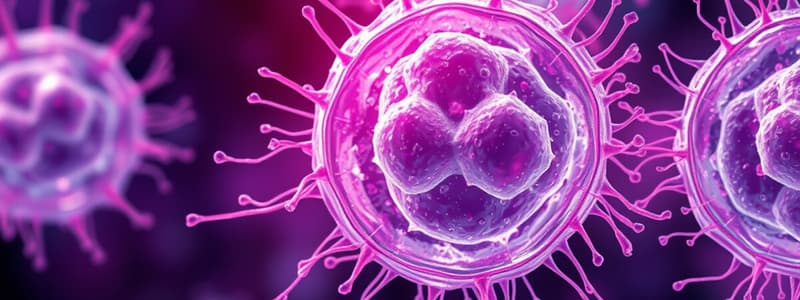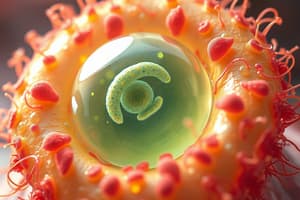Podcast
Questions and Answers
Which type of environment is most favorable for plant cells?
Which type of environment is most favorable for plant cells?
- Isothermal
- Hypertonic
- Isotonic
- Hypotonic (correct)
What defines active transport?
What defines active transport?
- Movement of substances across membranes against their concentration gradient using energy (correct)
- Movement of substances down their concentration gradient without energy
- Diffusion of water across a membrane
- Transfer of substances between cells without energy
What is the primary function of the sodium-potassium pump?
What is the primary function of the sodium-potassium pump?
- To balance the concentration of oxygen and carbon dioxide
- To maintain osmotic pressure within the cell
- To regulate calcium levels in the cell
- To transport sodium ions into the cell while expelling potassium ions (correct)
How does secondary active transport differ from primary active transport?
How does secondary active transport differ from primary active transport?
Which of the following is not a type of endocytosis?
Which of the following is not a type of endocytosis?
What is the role of valence electrons in chemical bonding?
What is the role of valence electrons in chemical bonding?
Which subatomic particle is primarily responsible for the identity of an element?
Which subatomic particle is primarily responsible for the identity of an element?
What characterizes a reversible chemical reaction?
What characterizes a reversible chemical reaction?
What distinguishes a polar covalent bond from a non-polar covalent bond?
What distinguishes a polar covalent bond from a non-polar covalent bond?
Which of the following elements is the most electronegative?
Which of the following elements is the most electronegative?
What type of bond is formed when electrons are transferred from one atom to another?
What type of bond is formed when electrons are transferred from one atom to another?
Which of the following best describes the structure of a water molecule?
Which of the following best describes the structure of a water molecule?
What is the role of buffers in biological systems?
What is the role of buffers in biological systems?
Which statement describes the relationship between hydrophobic and hydrophilic molecules?
Which statement describes the relationship between hydrophobic and hydrophilic molecules?
What is the characteristic ratio of hydrogen to oxygen in carbohydrates?
What is the characteristic ratio of hydrogen to oxygen in carbohydrates?
Which of the following is NOT a property of water that contributes to its uniqueness?
Which of the following is NOT a property of water that contributes to its uniqueness?
What is a major difference between prokaryotic and eukaryotic cells?
What is a major difference between prokaryotic and eukaryotic cells?
Which of the following components is NOT found in the cell membrane?
Which of the following components is NOT found in the cell membrane?
Which definition best describes passive transport?
Which definition best describes passive transport?
What type of environment can cause a cell to experience turgor pressure?
What type of environment can cause a cell to experience turgor pressure?
What feature distinguishes the cytoskeleton from other cellular structures?
What feature distinguishes the cytoskeleton from other cellular structures?
Which domains do prokaryotic cells belong to in the three domain system?
Which domains do prokaryotic cells belong to in the three domain system?
Which of the following statements about facilitated diffusion is true?
Which of the following statements about facilitated diffusion is true?
What best describes amphipathic molecules in the context of the plasma membrane?
What best describes amphipathic molecules in the context of the plasma membrane?
Study Notes
Microscopy Techniques
- Three types of microscopy: Light microscopy, Electron microscopy, and Dissecting microscopy.
- Light microscope uses visible light to magnify specimens; best for observing details of single cells.
- Dissecting microscope (stereomicroscope) offers lower magnification and a three-dimensional view; ideal for larger, opaque specimens.
- Electron microscopy uses beams of electrons for higher resolution images, capable of visualizing internal structures at the molecular level.
Cell Theory and Prokaryotic Cells
- Cell theory states that all living organisms are composed of cells, the cell is the basic unit of life, and all cells arise from pre-existing cells.
- Prokaryotic cells include structural components like plasma membrane, cytoplasm, ribosomes, and genetic material (DNA).
- Shared components between prokaryotic and eukaryotic cells: plasma membrane, cytoplasm, ribosomes, and genetic material.
- Prokaryotic cells are typically unicellular, lack a nucleus, have circular DNA, and are usually smaller than eukaryotic cells.
- In the three-domain system, prokaryotic cells belong to the domains Bacteria and Archaea.
- Bacteria are often characterized by peptidoglycan in their cell walls, while Archaea have unique membrane lipids and extremophiles.
- Prokaryotic cells reproduce through binary fission, a simple process where the cell divides into two identical daughter cells.
Eukaryotic Cells
- Cytoplasm consists of cytosol, organelles, and various cellular structures; it supports and confines cellular components.
- Flagella/Cilia assist in movement; nucleus houses genetic material; ribosomes synthesize proteins; rough endoplasmic reticulum is involved in protein processing; smooth endoplasmic reticulum synthesizes lipids.
- Golgi apparatus modifies, sorts, and packages proteins; vesicles/vacuoles store materials; lysosomes contain digestive enzymes; peroxisomes detoxify harmful substances; mitochondria produce ATP.
- Cytoskeleton provides structural support and facilitates movement; consists of microfilaments, intermediate filaments, and microtubules.
- Plant cells have a cell wall, chloroplasts, and large central vacuoles, while animal cells have centrioles and smaller vacuoles.
Cell Membrane
- All cells, including prokaryotic and eukaryotic, possess a plasma membrane.
- Plasma membrane components: phospholipids, proteins, carbohydrates, and cholesterol.
- The structure is a phospholipid bilayer with embedded proteins, allowing selective permeability.
- Functions of the plasma membrane include protecting the cell, regulating transport, and facilitating communication.
- Selective permeability allows certain molecules to cross while restricting others based on size, charge, and solubility.
- Phospholipids are amphipathic, containing hydrophilic heads and hydrophobic tails.
Transport Mechanisms
- Passive transport refers to the movement of molecules across membranes without energy, following concentration gradients.
- Diffusion allows small nonpolar molecules to pass freely, while larger or charged molecules require specific transport proteins.
- Facilitated diffusion assists molecules like glucose in crossing through channel or carrier proteins.
- Osmosis is the diffusion of water, influenced by solute concentrations; osmotic pressure is the force exerted by water movement.
- Turgor pressure refers to the pressure exerted by fluid in plant cells, maintaining rigidity.
- Solutions can be isotonic, hypotonic, or hypertonic, affecting water movement in cells.
Chemical Bonds
- A covalent bond involves sharing electrons, while polar covalent bonds have unequal sharing leading to partial charges.
- Electronegativity is the tendency of an atom to attract electrons, influenced by atomic size and electron configuration; fluorine is the most electronegative element.
- Ionic bonds form through the transfer of electrons between atoms, creating charged ions.
- Weak chemical bonds, such as hydrogen bonds, play a crucial role in stabilizing structures like DNA.
Water Properties
- The water molecule has a bent structure with polar covalent bonds, leading to unique properties.
- Hydrogen bonds between water molecules create cohesion and adhesion, crucial for biological processes.
- Water's emergent properties include cohesion, moderate temperature, expansion upon freezing, and versatility as a solvent.
pH and Buffers
- pH measures the acidity or basicity of a solution; neutral is pH 7.
- Acids donate protons, while bases accept them; most human body fluids are near pH 7, with exceptions like stomach acid.
- Buffers resist changes in pH by neutralizing acids or bases.
Biological Molecules
- Carbon's unique ability to form four stable covalent bonds makes it essential for life, allowing for complex molecules.
- Four classes of biological macromolecules: carbohydrates, proteins, lipids, and nucleic acids.
- Carbohydrates typically have a 1:2:1 ratio of carbon, hydrogen, and oxygen; examples include glucose (monomer) and starch (polymer).
- Amino acids are the building blocks of proteins, with diverse structures determining their functions.
Active Transport
- Active transport requires energy to move substances against their concentration gradient.
- The sodium-potassium pump actively transports Na+ out of and K+ into cells, critical for maintaining membrane potential.
- Secondary active transport utilizes energy from primary transport to move other substances.
Chemistry of Life
- Matter comprises elements and atoms; elements are pure substances, while atoms are the basic units of matter.
- Elements crucial for life include carbon, hydrogen, oxygen, and nitrogen, which constitute most biological molecules.
- Isotopes are variants of elements with different numbers of neutrons, affecting their stability.
Ions and Molecules
- Atoms become charged by gaining or losing electrons, forming ions.
- The octet rule states that atoms are most stable with eight electrons in their outer shell, influencing chemical reactivity.
Studying That Suits You
Use AI to generate personalized quizzes and flashcards to suit your learning preferences.
Description
Explore the fascinating world of cell study through microscopy techniques and cell theory. This quiz covers the types of microscopy, differences between prokaryotic and eukaryotic cells, and essential concepts in cellular biology. Perfect for biology students looking to deepen their understanding of cells.




